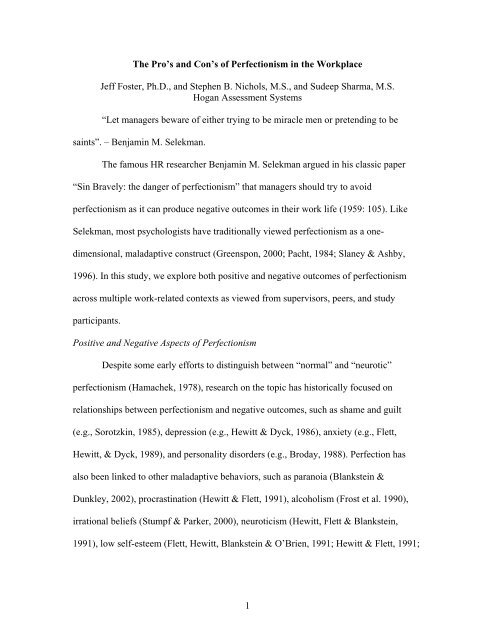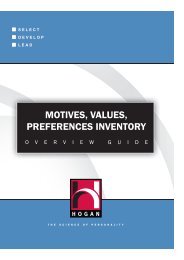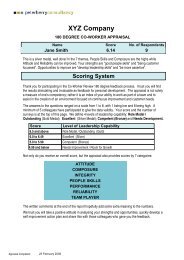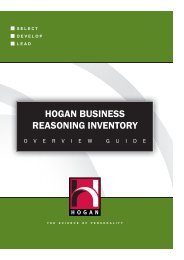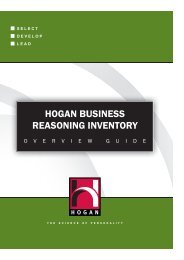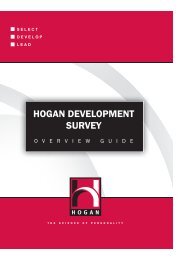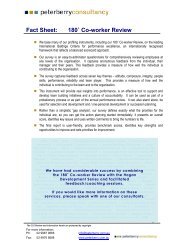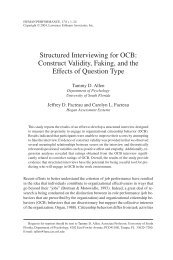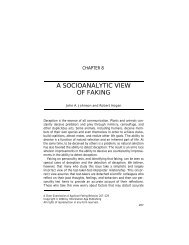The Pros and Cons of Perfectionism in the Workplace - Peter Berry ...
The Pros and Cons of Perfectionism in the Workplace - Peter Berry ...
The Pros and Cons of Perfectionism in the Workplace - Peter Berry ...
Create successful ePaper yourself
Turn your PDF publications into a flip-book with our unique Google optimized e-Paper software.
<strong>The</strong> Pro’s <strong>and</strong> Con’s <strong>of</strong> <strong>Perfectionism</strong> <strong>in</strong> <strong>the</strong> <strong>Workplace</strong><br />
Jeff Foster, Ph.D., <strong>and</strong> Stephen B. Nichols, M.S., <strong>and</strong> Sudeep Sharma, M.S.<br />
Hogan Assessment Systems<br />
“Let managers beware <strong>of</strong> ei<strong>the</strong>r try<strong>in</strong>g to be miracle men or pretend<strong>in</strong>g to be<br />
sa<strong>in</strong>ts”. – Benjam<strong>in</strong> M. Selekman.<br />
<strong>The</strong> famous HR researcher Benjam<strong>in</strong> M. Selekman argued <strong>in</strong> his classic paper<br />
“S<strong>in</strong> Bravely: <strong>the</strong> danger <strong>of</strong> perfectionism” that managers should try to avoid<br />
perfectionism as it can produce negative outcomes <strong>in</strong> <strong>the</strong>ir work life (1959: 105). Like<br />
Selekman, most psychologists have traditionally viewed perfectionism as a onedimensional,<br />
maladaptive construct (Greenspon, 2000; Pacht, 1984; Slaney & Ashby,<br />
1996). In this study, we explore both positive <strong>and</strong> negative outcomes <strong>of</strong> perfectionism<br />
across multiple work-related contexts as viewed from supervisors, peers, <strong>and</strong> study<br />
participants.<br />
Positive <strong>and</strong> Negative Aspects <strong>of</strong> <strong>Perfectionism</strong><br />
Despite some early efforts to dist<strong>in</strong>guish between “normal” <strong>and</strong> “neurotic”<br />
perfectionism (Hamachek, 1978), research on <strong>the</strong> topic has historically focused on<br />
relationships between perfectionism <strong>and</strong> negative outcomes, such as shame <strong>and</strong> guilt<br />
(e.g., Sorotzk<strong>in</strong>, 1985), depression (e.g., Hewitt & Dyck, 1986), anxiety (e.g., Flett,<br />
Hewitt, & Dyck, 1989), <strong>and</strong> personality disorders (e.g., Broday, 1988). Perfection has<br />
also been l<strong>in</strong>ked to o<strong>the</strong>r maladaptive behaviors, such as paranoia (Blankste<strong>in</strong> &<br />
Dunkley, 2002), procrast<strong>in</strong>ation (Hewitt & Flett, 1991), alcoholism (Frost et al. 1990),<br />
irrational beliefs (Stumpf & Parker, 2000), neuroticism (Hewitt, Flett & Blankste<strong>in</strong>,<br />
1991), low self-esteem (Flett, Hewitt, Blankste<strong>in</strong> & O’Brien, 1991; Hewitt & Flett, 1991;<br />
1
Slaney, Rice & Ashby, 2002), suicide (Hewitt, Cael<strong>in</strong>, Flett, Sherry, Coll<strong>in</strong>s & Flynn,<br />
2002), <strong>and</strong> social phobia (Antony, Purdon, Huta & Sw<strong>in</strong>son 1998).<br />
More recent work, however, has <strong>in</strong>dicated that perfectionism may be multidimensional<br />
<strong>in</strong> nature (Hewitt & Flett, 1991) <strong>and</strong> can result <strong>in</strong> both positive <strong>and</strong> negative<br />
outcomes (Frost, Heimberg, Holt, Mattia, & Neubauer, 1993; Parker, 1997; Rice &<br />
Slaney, 2002; Slaney & Ashby, 1996). Accord<strong>in</strong>g to Maslow, striv<strong>in</strong>g for perfection<br />
through self-actualization is an “<strong>in</strong>dication <strong>of</strong> <strong>the</strong> absence <strong>of</strong> neurosis” (<strong>Peter</strong>s, 2005: 3).<br />
Silverman (2005) argues that <strong>the</strong> root <strong>of</strong> excellence is perfectionism; it is what motivates<br />
<strong>in</strong>dividuals to achiev<strong>in</strong>g higher goals (<strong>in</strong> <strong>Peter</strong>s, 2005). Frost <strong>and</strong> colleague’s found that<br />
<strong>the</strong> high personal <strong>and</strong> organizational st<strong>and</strong>ards are typically associated with healthy<br />
experiences (Frost, Lahart & Rosenblate, 1991; Frost & Mart<strong>in</strong>, 1990). F<strong>in</strong>ally, Hewitt<br />
<strong>and</strong> Flett argue that self-oriented perfectionism, <strong>and</strong> to a lesser extent, o<strong>the</strong>r-oriented<br />
perfectionism, is associated with adaptive social skills (Flett & Hewitt, 2002; Flett,<br />
Hewitt & De Rosa, 1996).<br />
In a study <strong>of</strong> self-efficacy <strong>in</strong> career decision mak<strong>in</strong>g, Ashby, Bieschke, <strong>and</strong><br />
Slaney (1997) found that those classified as adaptive perfectionists had significantly<br />
higher scores <strong>of</strong> accurate self-appraisal, goal selection, mak<strong>in</strong>g plans for <strong>the</strong> future <strong>and</strong><br />
problem-solv<strong>in</strong>g (Slaney et al, 2002) as compared to those classified as nonperfectionists.<br />
Fur<strong>the</strong>rmore, self-oriented perfectionism has been associated with a<br />
number <strong>of</strong> positive adaptive qualities, <strong>in</strong>clud<strong>in</strong>g achievement striv<strong>in</strong>g, positive affect,<br />
high self-esteem, self-efficacy, self-actualization, resourcefulness, perceived control,<br />
adaptive cop<strong>in</strong>g with stress, positive appraisals <strong>of</strong> personal projects, adaptive learn<strong>in</strong>g<br />
strategies, good academic performance, <strong>and</strong> positive <strong>in</strong>terpersonal characteristics, such as<br />
2
self-assurance, assertiveness, <strong>and</strong> altruistic social attitudes (Blankste<strong>in</strong> & Dunkley, 2002;<br />
Burns & Fedewa, 2005). O<strong>the</strong>r-oriented perfectionism has been associated with an<br />
elevated level <strong>of</strong> assertiveness (Flett et al. 1996).<br />
Conceptualizations <strong>of</strong> <strong>Perfectionism</strong><br />
Two ma<strong>in</strong> conceptualizations <strong>of</strong> perfectionism emerge <strong>in</strong> <strong>the</strong> literature. Frost et al.<br />
(1990) identified perfectionism as hav<strong>in</strong>g five dimensions. <strong>The</strong> first dimension, which <strong>the</strong><br />
authors considered <strong>the</strong> major dimension, is concern over mistakes. This reflects a<br />
tendency to <strong>in</strong>terpret mistakes as equivalent to failure, <strong>and</strong> <strong>the</strong> belief that one will lose <strong>the</strong><br />
respect <strong>of</strong> o<strong>the</strong>rs follow<strong>in</strong>g failure. <strong>The</strong> second dimension is <strong>the</strong> sett<strong>in</strong>g <strong>of</strong> excessively<br />
high personal st<strong>and</strong>ards, which <strong>in</strong>dividuals <strong>of</strong>ten fail to meet. <strong>The</strong> third dimension is<br />
parental expectations, which <strong>in</strong>volves <strong>the</strong> extent to which an <strong>in</strong>dividual’s parents are<br />
perceived as sett<strong>in</strong>g high expectations. <strong>The</strong> fourth dimension is parental criticism,<br />
which <strong>in</strong>volves <strong>the</strong> extent to which an <strong>in</strong>dividual’s parents are overly critical. <strong>The</strong> f<strong>in</strong>al<br />
dimension is doubts about actions, which is <strong>the</strong> tendency to doubt <strong>the</strong> quality <strong>of</strong> one’s<br />
performance. Subsequent researchers added a sixth dimension to this model, named<br />
organization, which reflects an <strong>in</strong>dividual’s tendency to be orderly <strong>and</strong> organized<br />
(Alden, Ryder & Mell<strong>in</strong>gs, 2002; Frost et al. 1990; Frost, Turcotte, Heimberg, Mattia,<br />
Holt & Hope, 1995)<br />
Alternatively, Hewitt <strong>and</strong> Flett (1991) identified three dimensions <strong>of</strong><br />
perfectionism. Accord<strong>in</strong>g to this conceptualization, although <strong>the</strong> behaviors exhibited are<br />
frequently similar among <strong>the</strong> dimensions, <strong>the</strong> dist<strong>in</strong>guish<strong>in</strong>g features among <strong>the</strong><br />
dimensions <strong>in</strong>volve (a) from whom <strong>the</strong> perfectionist expectations derive (i.e. <strong>the</strong> self or<br />
o<strong>the</strong>rs) <strong>and</strong> (b) to whom <strong>the</strong> behaviors are directed (i.e. toward <strong>the</strong> self or o<strong>the</strong>rs) (Hewitt<br />
3
& Flett, 2002). <strong>The</strong> first dimension is self-oriented perfectionism, <strong>in</strong> which <strong>the</strong> <strong>in</strong>dividual<br />
has unrealistic st<strong>and</strong>ards for <strong>the</strong>mselves, strives for <strong>the</strong>se st<strong>and</strong>ards, is overly critical <strong>of</strong><br />
<strong>the</strong>mselves, tends to overly focus on <strong>the</strong>ir flaws, <strong>and</strong> tries to avoid failure. <strong>The</strong> second<br />
dimension is o<strong>the</strong>r-oriented perfectionism, <strong>in</strong> which <strong>the</strong> <strong>in</strong>dividual has unrealistic<br />
st<strong>and</strong>ards <strong>and</strong> expectations about <strong>the</strong> abilities <strong>of</strong> o<strong>the</strong>rs <strong>and</strong> is <strong>of</strong>ten overly evaluative <strong>of</strong><br />
o<strong>the</strong>rs’ performance. <strong>The</strong> third dimension is socially-prescribed perfectionism, <strong>in</strong> which<br />
<strong>the</strong> <strong>in</strong>dividual believes that o<strong>the</strong>rs have perfectionist expectations <strong>and</strong> motives about <strong>the</strong>m<br />
<strong>and</strong> feels that <strong>the</strong>y must atta<strong>in</strong> <strong>the</strong>se st<strong>and</strong>ards (Blankste<strong>in</strong> & W<strong>in</strong>kworth, 2004; Hewitt &<br />
Flett, 1991; Kobori, Yamagata & Kijima, 2005).<br />
We do not <strong>in</strong>tend for this review to be exclusive or exhaustive, but ra<strong>the</strong>r to<br />
illustrate <strong>the</strong> multidimensional <strong>and</strong> multi-categorical nature <strong>of</strong> perfectionism. In this<br />
paper, we present research that fur<strong>the</strong>r <strong>in</strong>vestigates <strong>the</strong> relationships between<br />
perfectionism <strong>and</strong> a range <strong>of</strong> work outcomes. Specifically, we exam<strong>in</strong>e <strong>the</strong> direction <strong>and</strong><br />
magnitude <strong>of</strong> <strong>the</strong> relationship between perfectionism <strong>and</strong> different work related<br />
competencies as rated from multiple perspectives.<br />
Methods<br />
Predictor Scale<br />
In <strong>the</strong> present study, we exam<strong>in</strong>ed <strong>the</strong> effects <strong>of</strong> self-oriented perfectionism at<br />
work. We assessed perfectionism us<strong>in</strong>g <strong>the</strong> Hogan Development Survey (Hogan &<br />
Hogan, 1997). <strong>The</strong> HDS is a 168-item self-report assessment that conta<strong>in</strong>s 11 primary<br />
scales. <strong>The</strong>se scales <strong>in</strong>dex behavioral tendencies that can emerge <strong>and</strong> negatively impact<br />
performance, particularly when an <strong>in</strong>dividual is fatigued, ill, stressed, bored, or lack<strong>in</strong>g<br />
social vigilance.<br />
4
Specifically, we exam<strong>in</strong>ed relationships between <strong>the</strong> HDS Diligent scale <strong>and</strong><br />
work related outcomes. <strong>The</strong> Diligent scale measures <strong>the</strong> degree to which a person is<br />
picky, critical, <strong>and</strong> overly conscientious. High scorers on <strong>the</strong> Diligent scale are typically<br />
viewed by o<strong>the</strong>rs as resistant to change, micromanag<strong>in</strong>g, stubborn when under pressure,<br />
<strong>and</strong> slow to make decisions (Hogan, Hogan, & Warrenfeltz, 2007).<br />
<strong>The</strong> Diligent scale predicts behaviors rang<strong>in</strong>g from be<strong>in</strong>g relaxed, tolerant, <strong>and</strong><br />
will<strong>in</strong>g to delegate at <strong>the</strong> low end to be<strong>in</strong>g meticulous, picky, critical, <strong>and</strong> overly<br />
conscientious at <strong>the</strong> high end. <strong>The</strong> HDS Technical Manual (R. Hogan & J. Hogan, 2009)<br />
specifically states that people with high scores on <strong>the</strong> Diligent scale are viewed by o<strong>the</strong>rs<br />
as be<strong>in</strong>g perfectionistic. As fur<strong>the</strong>r outl<strong>in</strong>ed <strong>in</strong> <strong>the</strong> manual:<br />
<strong>The</strong>ir meticulous attention to detail is useful <strong>and</strong> even important <strong>in</strong> many jobs, but<br />
it has a down side, too. Such people have trouble prioritiz<strong>in</strong>g <strong>the</strong>ir work because<br />
<strong>the</strong>y believe that every task must be done equally well--which becomes<br />
<strong>in</strong>creas<strong>in</strong>gly difficult as a person becomes busier. <strong>The</strong>y have trouble delegat<strong>in</strong>g--<br />
because <strong>the</strong>y want to be sure that th<strong>in</strong>gs are done right--which deprives <strong>the</strong>ir<br />
subord<strong>in</strong>ates <strong>of</strong> opportunities to learn. <strong>The</strong>y tend to micromanage <strong>the</strong>ir staff, <strong>and</strong><br />
<strong>the</strong>ir conservatism may make <strong>the</strong>m resistant to change. <strong>The</strong>y will be good with<br />
details, but <strong>the</strong>y will rarely be a source <strong>of</strong> true <strong>in</strong>novation. At <strong>the</strong>ir best, <strong>the</strong>se<br />
people are good role models who uphold <strong>the</strong> highest st<strong>and</strong>ards <strong>of</strong> pr<strong>of</strong>essionalism<br />
<strong>in</strong> performance <strong>and</strong> comportment; <strong>the</strong>y are typically popular with <strong>the</strong>ir bosses<br />
because <strong>the</strong>y are so reliable. At <strong>the</strong>ir worst, however, <strong>the</strong>y are fussy, particular,<br />
nit-pick<strong>in</strong>g micro-managers who deprive <strong>the</strong>ir subord<strong>in</strong>ates <strong>of</strong> any choice or<br />
control over <strong>the</strong>ir work. <strong>The</strong> micro-management alienates <strong>the</strong>ir staff who soon<br />
5
efuse to take any <strong>in</strong>itiative <strong>and</strong> simply wait to be told what to do <strong>and</strong> how to do<br />
it. (p. 55)<br />
<strong>The</strong> HDS Technical Manual (R. Hogan & J. Hogan, 2009) also provides evidence<br />
about <strong>the</strong> construct validity <strong>of</strong> <strong>the</strong> HDS Diligent scale when compared to a number <strong>of</strong><br />
o<strong>the</strong>r well validated personality measures. Specifically, Diligent has demonstrated<br />
significant positive correlations with <strong>the</strong> Prudence scale on <strong>the</strong> Hogan Personality<br />
Inventory (R. Hogan & J. Hogan, 2009; r = .31), <strong>the</strong> Order (r = .47) <strong>and</strong> <strong>Cons</strong>cientious<br />
scales on <strong>the</strong> NEO PI-R (Costa & McCrae, 1992; r = .45), <strong>the</strong> <strong>Cons</strong>cientious scale on <strong>the</strong><br />
IPIP (r = .61), <strong>and</strong> <strong>the</strong> <strong>Perfectionism</strong> scale on <strong>the</strong> 16PF (Conn & Rieke, 1994; r = .55). It<br />
has also demonstrated significant negative relationships with <strong>the</strong> CPI Flexibility scale<br />
(Gough, 1975; r = -.49). When compared to scales on <strong>the</strong> Motives, Values, <strong>and</strong><br />
Preferences Inventory (J. Hogan & R. Hogan, 1997), which conta<strong>in</strong>s ten scales <strong>in</strong>dicat<strong>in</strong>g<br />
what motives employees <strong>in</strong> <strong>the</strong>ir jobs, <strong>in</strong>dividuals with high scores on Diligent are also<br />
likely to score high on Security (r = .47) <strong>and</strong> Commerce (r = .32).<br />
In general, <strong>the</strong>se results <strong>in</strong>dicate that high scores on <strong>the</strong> Diligent scale reflect a<br />
number <strong>of</strong> potentially beneficial characteristics, such as be<strong>in</strong>g orderly, attentive to details,<br />
fastidious, <strong>and</strong> precise. In contrast, high score may also reflect a number <strong>of</strong> negative<br />
characteristics, such as be<strong>in</strong>g overly controll<strong>in</strong>g, rigid, <strong>in</strong>flexible, resistant to change,<br />
prejudice, <strong>in</strong>tolerance, <strong>and</strong> compulsive. Fur<strong>the</strong>rmore, <strong>in</strong>dividuals with high Diligent<br />
scores are likely to be driven by a desire for job security <strong>and</strong> money. F<strong>in</strong>ally,<br />
comparisons to scores on cognitive ability assessments <strong>in</strong>dicate that Diligent may show<br />
negative correlations with both tactical <strong>and</strong> strategic reason<strong>in</strong>g, as well as verbal fluency<br />
(R. Hogan & J. Hogan, 2009).<br />
6
Based on studies compar<strong>in</strong>g Diligent scores to adjective checklists filled out by<br />
<strong>in</strong>dividuals who are familiar with <strong>the</strong> participant, <strong>the</strong> HDS Technical Manual <strong>in</strong>dicates<br />
that <strong>in</strong>dividuals with high scores on Diligent are viewed by observers as organized (r =<br />
.36), systematic (r = .34), efficient (r = .31) <strong>and</strong> practical (r = .19). Observers also<br />
<strong>in</strong>dicate that <strong>the</strong>y do th<strong>in</strong>gs effectively (r = .28), do a thorough job (r = .25), make plans<br />
<strong>and</strong> follow through (r = .24), <strong>and</strong> persevere until tasks are completed (r = .19) (R. Hogan<br />
& J. Hogan, 2009). <strong>The</strong>se results not only parallel many common def<strong>in</strong>itions <strong>of</strong><br />
perfectionism, but also demonstrate how perfectionism can be viewed as both positively<br />
<strong>and</strong> negatively by o<strong>the</strong>rs.<br />
Criterion Measures<br />
To exam<strong>in</strong>e relationships between perfectionism <strong>and</strong> work outcomes, we used<br />
data from <strong>the</strong> Hogan archive. <strong>The</strong> archive conta<strong>in</strong>s results from over 250 criterion-related<br />
validity studies conducted over <strong>the</strong> last 20 years. <strong>The</strong> studies represent a range <strong>of</strong> jobs,<br />
organizations, <strong>and</strong> <strong>in</strong>dustries. For use <strong>in</strong> syn<strong>the</strong>tic validity (see Hogan, Davies, & Hogan,<br />
2007), criterion data <strong>in</strong> <strong>the</strong> Hogan archive is categorized <strong>in</strong>to 56 competencies. <strong>The</strong>se<br />
competencies represent behaviors that are frequently rated as critical for success <strong>in</strong><br />
multiple jobs, such as goal sett<strong>in</strong>g, teamwork, dependability, <strong>in</strong>terpersonal skills, <strong>and</strong><br />
trustworth<strong>in</strong>ess.<br />
McClell<strong>and</strong> <strong>and</strong> his colleagues (e.g., Boyatzis, 1982) <strong>in</strong>troduced <strong>the</strong> concept <strong>of</strong><br />
competency, which <strong>the</strong>y def<strong>in</strong>ed as performance capabilities that dist<strong>in</strong>guish effective<br />
from <strong>in</strong>effective personnel. McClell<strong>and</strong> def<strong>in</strong>ed competencies empirically <strong>in</strong> terms <strong>of</strong> <strong>the</strong><br />
requirements <strong>of</strong> particular jobs <strong>in</strong> particular contexts. This rigorous approach is rare <strong>in</strong> a<br />
field characterized by ad hoc competency models. We developed our list <strong>of</strong> competencies<br />
7
ased on an extensive review <strong>of</strong> over 30 competencies models used by organizations<br />
<strong>and</strong>/or presented <strong>in</strong> peer review journals.<br />
<strong>The</strong> studies <strong>in</strong>cluded are empirical validation studies with ei<strong>the</strong>r supervisor rat<strong>in</strong>gs<br />
as criteria or 360 degree feedback rat<strong>in</strong>gs as criteria. We categorized rat<strong>in</strong>gs by each <strong>of</strong><br />
our 56 competencies. All data were collected <strong>in</strong> <strong>the</strong> English language, although some<br />
studies were completed us<strong>in</strong>g data collected outside <strong>of</strong> <strong>the</strong> US. All studies <strong>in</strong>cluded one<br />
or more types <strong>of</strong> job analyses dur<strong>in</strong>g <strong>the</strong> <strong>in</strong>itial stages <strong>of</strong> <strong>the</strong> research. Over 40% <strong>of</strong> <strong>the</strong><br />
studies (k = 11) used an evaluation <strong>of</strong> job competencies that led to <strong>the</strong> development <strong>of</strong><br />
competency-based criterion rat<strong>in</strong>g scales. Several studies used worker-oriented methods<br />
to determ<strong>in</strong>e <strong>the</strong> knowledge, skills, <strong>and</strong> abilities required for successful job performance.<br />
<strong>The</strong>se job analyses generally followed <strong>the</strong> Goldste<strong>in</strong>, Zedeck, <strong>and</strong> Schneider (1993)<br />
method for content validation research (cf. R. Hogan & Hogan, 1995, p. 75). <strong>The</strong><br />
rema<strong>in</strong><strong>in</strong>g studies (k =15) used <strong>the</strong> Job Evaluation Tool. This personality-based job<br />
analysis uses questionnaire rat<strong>in</strong>g items to pr<strong>of</strong>ile jobs <strong>in</strong> terms <strong>of</strong> <strong>the</strong> FFM dimensions,<br />
derailment characteristics, work group values, <strong>and</strong> competencies required. Raymark,<br />
Schmit, <strong>and</strong> Guion (1997) describe a similar method for evaluat<strong>in</strong>g personality-based job<br />
requirements. Although job analysis results are <strong>of</strong>ten used to justify predictor measures,<br />
<strong>the</strong>se results were used to develop criterion dimensions.<br />
Samples<br />
We identified 26 <strong>in</strong>dependent samples (total N = 3,059) from published articles,<br />
chapters, technical reports, <strong>and</strong> dissertations between 1997 <strong>and</strong> 2008 that were catalogued<br />
<strong>in</strong> our archive. <strong>The</strong> studies met <strong>the</strong> follow<strong>in</strong>g criteria: (a) <strong>the</strong>y used job analysis to<br />
estimate personality-based job requirements; (b) <strong>the</strong>y used a concurrent (k = 11) or<br />
8
predictive (k = 15) validation strategy with work<strong>in</strong>g adults; (c) <strong>the</strong> criteria were content<br />
explicit, not just overall job performance, <strong>and</strong> <strong>the</strong>se were classified reliably by subject<br />
matter experts; <strong>and</strong> (d) <strong>the</strong> predictor variables were scales <strong>of</strong> <strong>the</strong> HDS. We excluded<br />
studies us<strong>in</strong>g: (a) cl<strong>in</strong>ical patients <strong>and</strong> <strong>the</strong>rapists; (b) undergraduate or graduate students;<br />
(c) only self-reported performance criteria; (d) performance criteria o<strong>the</strong>r than rat<strong>in</strong>gs; (e)<br />
only an overall performance criterion; (f) laboratory or assessment center studies; <strong>and</strong> (g)<br />
studies unrelated to work contexts. Studies compiled for <strong>the</strong> meta-analysis are from<br />
occupational samples <strong>of</strong> managers, executives, <strong>and</strong> pr<strong>of</strong>essionals. Both number <strong>of</strong> studies<br />
<strong>and</strong> sample sizes varied by competency.<br />
Analyses<br />
We used <strong>the</strong> meta-analytic procedures specified by Hunter <strong>and</strong> Schmidt (1990) to<br />
cumulate results across studies <strong>and</strong> to assess effect sizes. All studies used zero-order<br />
product-moment correlations, which elim<strong>in</strong>ated <strong>the</strong> need to convert alternative statistics<br />
to values <strong>of</strong> r. Corrections were made for sampl<strong>in</strong>g error, unreliability <strong>in</strong> <strong>the</strong> measures,<br />
<strong>and</strong> range restriction. Reliability <strong>of</strong> <strong>the</strong> personality measures was estimated us<strong>in</strong>g with<strong>in</strong>study<br />
coefficient alpha [M = .59; range = .43 (Leisurely) to .68 (Cautious, Colorful)],<br />
ra<strong>the</strong>r than rely<strong>in</strong>g exclusively on <strong>the</strong> values reported <strong>in</strong> <strong>the</strong> 1997 HDS manual. Although<br />
some researchers (e.g., Murphy & De Shon, 2000) argue aga<strong>in</strong>st <strong>the</strong> use <strong>of</strong> rater-based<br />
reliability estimates, we followed procedures outl<strong>in</strong>ed by Barrick <strong>and</strong> Mount (1991) <strong>and</strong><br />
Tett et al. (1991), <strong>and</strong> used <strong>the</strong> .508 reliability coefficient proposed by Rothste<strong>in</strong> (1990)<br />
as <strong>the</strong> estimate <strong>of</strong> <strong>the</strong> reliability <strong>of</strong> supervisory rat<strong>in</strong>gs <strong>of</strong> job performance. <strong>The</strong><br />
frequency-weighted mean <strong>of</strong> <strong>the</strong> job performance reliability distribution was .59, which is<br />
comparable to <strong>the</strong> value <strong>of</strong> .56 reported by Barrick <strong>and</strong> Mount (1991), <strong>and</strong> <strong>the</strong> mean<br />
9
square root reliability <strong>of</strong> .76 corresponds to <strong>the</strong> value <strong>of</strong> .778 reported by Tett et al.<br />
(1991). Also, we computed a range restriction <strong>in</strong>dex for HDS scales. Follow<strong>in</strong>g<br />
procedures described by Hunter <strong>and</strong> Schmidt (1990), we divided each HDS scale’s<br />
with<strong>in</strong>-study st<strong>and</strong>ard deviation by <strong>the</strong> st<strong>and</strong>ard deviation reported <strong>in</strong> <strong>the</strong> HDS Technical<br />
Manual. This procedure produced an <strong>in</strong>dex <strong>of</strong> range restriction for each HDS scale with<strong>in</strong><br />
each study, <strong>and</strong> we used <strong>the</strong>se values to correct each predictor scale for range restriction.<br />
Our procedure uses both negative <strong>and</strong> positive correlations ra<strong>the</strong>r than mean<br />
absolute values for averag<strong>in</strong>g correlations. This is <strong>the</strong> major computational difference<br />
between <strong>the</strong> current analyses <strong>and</strong> those presented by Tett et al. (1991, p. 712). We did not<br />
correct correlation coefficients to estimate validity at <strong>the</strong> construct level. Although some<br />
(e.g., Mount & Barrick, 1995a; Ones, Schmidt, & Viswesvaran, 1994) argue this is a<br />
relevant artifact that can be corrected, we believe it is premature to estimate <strong>the</strong> validity<br />
<strong>of</strong> <strong>the</strong> perfect construct when <strong>the</strong>re is no firm agreement on <strong>the</strong> def<strong>in</strong>ition <strong>of</strong> <strong>the</strong> perfect<br />
construct.<br />
We used meta-analysis to exam<strong>in</strong>e relationships between scores on <strong>the</strong> Diligent<br />
scale <strong>and</strong> each competency. Meta-analysis averages f<strong>in</strong>d<strong>in</strong>gs from multiple studies<br />
exam<strong>in</strong><strong>in</strong>g relationships between similar variables. <strong>The</strong> procedure controls for error due<br />
to sampl<strong>in</strong>g, measurement, range restriction, <strong>and</strong> potential moderat<strong>in</strong>g variables <strong>and</strong><br />
provides a best estimate <strong>of</strong> <strong>the</strong>se relationships across jobs <strong>and</strong> organizations (Smith &<br />
Glass, 1977). Moderators represent o<strong>the</strong>r job or organizational characteristics that affect<br />
<strong>the</strong> relations under exam<strong>in</strong>ation.<br />
We used procedures outl<strong>in</strong>ed by Hunter <strong>and</strong> Schmidt (2004), who argue that<br />
differences <strong>in</strong> a test’s validity across studies reflect statistical artifacts (e.g., sampl<strong>in</strong>g<br />
10
deficiency) <strong>and</strong> measurement problems (e.g., predictor/criterion unreliability, range<br />
restriction) ra<strong>the</strong>r than o<strong>the</strong>r characteristics unique to specific jobs or situations. <strong>The</strong>se<br />
meta-analytic procedures demonstrate that correlations between performance measures<br />
<strong>and</strong> cognitive ability tests (Schmidt & Hunter, 1977), biographical data <strong>in</strong>ventories<br />
(Schmidt & Rothste<strong>in</strong>, 1994), personality <strong>in</strong>ventories (Barrick & Mount, 1991; Barrick,<br />
Mount, & Gupta, 2003; Hogan & Holl<strong>and</strong>, 2003; Hough, 1992; Judge, Bono, Ilies, &<br />
Gerhardt, 2002; Salgado, 1997, 1998; Tett, Jackson, & Rothste<strong>in</strong>, 1991), assessment<br />
center exercises (Arthur, Day, McNelly, & Edens, 2003; Gaugler, Rosenthal, Thornton,<br />
& Benson, 1987), <strong>and</strong> situational judgment tests (McDaniel, Morgeson, F<strong>in</strong>negan,<br />
Campion, & Braverman, 2001) generalize across jobs <strong>and</strong> organizations.<br />
Results<br />
Data for all three rater types were available for 37 competencies, <strong>of</strong> which 18<br />
produced at least one significant outcome, which is significantly higher than one would<br />
expect due to chance at a p < .05 alpha level. Table 1 presents <strong>the</strong> results for<br />
competencies with at least one significant outcome.<br />
[Insert Table 1 about here]<br />
As shown <strong>in</strong> Table 1, scores on <strong>the</strong> HDS Diligent scale were positively related to<br />
supervisory rat<strong>in</strong>gs <strong>of</strong> <strong>in</strong>itiative, peer rat<strong>in</strong>gs <strong>of</strong> both <strong>in</strong>itiative <strong>and</strong> meets goals, <strong>and</strong> selfreport<br />
rat<strong>in</strong>gs for all 18 competencies <strong>in</strong>cluded <strong>in</strong> <strong>the</strong> table except for stress tolerance.<br />
Fur<strong>the</strong>rmore, HDS Diligent scores were negatively related to supervisory rat<strong>in</strong>gs <strong>of</strong><br />
f<strong>in</strong>ancial acumen, motivat<strong>in</strong>g o<strong>the</strong>rs, negotiation, risk management, stress tolerance, <strong>and</strong><br />
valu<strong>in</strong>g diversity. <strong>The</strong>y were also negatively related to peer rat<strong>in</strong>gs <strong>of</strong> f<strong>in</strong>ancial acumen,<br />
11
leadership, <strong>and</strong> risk management. <strong>The</strong>re were no significant negative relationships with<br />
self-report rat<strong>in</strong>gs.<br />
Discussion<br />
We found that perfectionism demonstrated both positive <strong>and</strong> negative<br />
relationships with multiple competencies. <strong>The</strong> majority <strong>of</strong> self-report performance rat<strong>in</strong>gs<br />
were positively correlated with perfectionism, <strong>in</strong>dicat<strong>in</strong>g that perfectionists tend to view<br />
<strong>the</strong>mselves as good performers across a variety <strong>of</strong> work areas. In contrast, <strong>the</strong> direction <strong>of</strong><br />
<strong>the</strong> relationships varied by competency for both supervisor <strong>and</strong> peer rat<strong>in</strong>gs, although <strong>the</strong><br />
majority <strong>of</strong> significant relationships were negative.<br />
To vary<strong>in</strong>g magnitudes, all three sources tended to agree that perfectionists show<br />
above average <strong>in</strong>itiative <strong>and</strong> service orientation. Even more <strong>in</strong>terest<strong>in</strong>g, however, is areas<br />
where <strong>the</strong> direction <strong>of</strong> <strong>the</strong> relationships changed accord<strong>in</strong>g to rater source. For example,<br />
perfectionists tend to rate <strong>the</strong>mselves high on f<strong>in</strong>ancial acumen, <strong>in</strong>dicat<strong>in</strong>g that <strong>the</strong>y are<br />
good at work<strong>in</strong>g with equations, underst<strong>and</strong><strong>in</strong>g f<strong>in</strong>ancial <strong>in</strong>formation, <strong>and</strong> forecast<strong>in</strong>g<br />
future bus<strong>in</strong>ess <strong>and</strong> market trends. Supervisors <strong>and</strong> peers both disagree, demonstrat<strong>in</strong>g<br />
much less confidence <strong>in</strong> <strong>the</strong> f<strong>in</strong>ancial acumen <strong>of</strong> perfectionists. <strong>The</strong> same general pattern<br />
can be found for dependability, leadership, risk management, <strong>and</strong> valu<strong>in</strong>g diversity.<br />
<strong>The</strong>se results <strong>in</strong>dicate that, <strong>in</strong> many cases, what perfectionists view as strengths, o<strong>the</strong>rs<br />
tend to view as problem areas.<br />
In general, results for this study confirm previous research on perfectionism when<br />
exam<strong>in</strong>ed <strong>in</strong> relationship to specific job rat<strong>in</strong>gs. From <strong>the</strong> perspective <strong>of</strong> supervisors <strong>and</strong><br />
peers, perfectionism is viewed as produc<strong>in</strong>g both positive <strong>and</strong> negative outcomes.<br />
Individuals who are high on perfectionism measures, however, tend to view <strong>the</strong>mselves<br />
12
<strong>in</strong> a very positive light. In o<strong>the</strong>r words, what perfectionists see as positive personal<br />
characteristics are <strong>of</strong>ten viewed by o<strong>the</strong>rs as neutral, or even negative.<br />
13
References<br />
Alden, L.E., Ryder, A.G., & Mell<strong>in</strong>gs, T.M.B. (2002). <strong>Perfectionism</strong> <strong>in</strong> <strong>the</strong> Context <strong>of</strong><br />
Social Fears: Toward a Two-Component Model. In G.L. Flett & P.L. Hewitt,<br />
(Eds.). <strong>Perfectionism</strong>: <strong>The</strong>ory, Research <strong>and</strong> Treatment. (pp. 373-391)<br />
Wash<strong>in</strong>gton, DC: American Psychological Association.<br />
Ashby, J., Bieschke, K., & Slaney, R. (1997, August). Multidimensional perfectionism<br />
<strong>and</strong> career decision-mak<strong>in</strong>g self-efficacy. Poster presented at <strong>the</strong> annual<br />
meet<strong>in</strong>g <strong>of</strong> <strong>the</strong> American Psychological Association, Chicago, IL.<br />
Antony, M.M., Biel<strong>in</strong>g, P.J., Cox, B.J., Enns, M.W., & Sw<strong>in</strong>son, R.P. (1998).<br />
Psychometric properties <strong>of</strong> <strong>the</strong> 42-Item <strong>and</strong> 21-Item versions <strong>of</strong> <strong>the</strong> depression<br />
anxiety stress scales <strong>in</strong> cl<strong>in</strong>ical groups <strong>and</strong> a community sample. Psychological<br />
Assessment, 10, 176-181.<br />
Barrick, M. R., & Mount, M. K. (1991). <strong>The</strong> Big-Five personality dimensions <strong>and</strong> job<br />
performance: A meta-analysis. Personnel Psychology, 44, 1-26.<br />
Barrick, M. R., Mount, M. K. & Gupta, R. (2003). Meta-Analysis <strong>of</strong> <strong>the</strong> relationship<br />
between <strong>the</strong> Five-Factor model <strong>of</strong> personality <strong>and</strong> Holl<strong>and</strong>’s occupational types.<br />
Personnel Psychology, 56, 45-74.<br />
Blankste<strong>in</strong>, K.R., & Dunkley, D.M. (2002). Evaluative concerns, self-critical, <strong>and</strong><br />
personal st<strong>and</strong>ards perfectionism: A structural equation model<strong>in</strong>g strategy. In G.L.<br />
Flett & P.L. Hewitt, (Eds.). <strong>Perfectionism</strong>: <strong>The</strong>ory, Research <strong>and</strong> Treatment. (pp<br />
285-315). Wash<strong>in</strong>gton, DC: American Psychological Association.<br />
14
Blankste<strong>in</strong>, K.R., & W<strong>in</strong>kworth, G.R. (2004). Dimensions <strong>of</strong> perfectionism <strong>and</strong> levels <strong>of</strong><br />
attributions for grades: Relations with dysphoria <strong>and</strong> academic performance.<br />
Journal <strong>of</strong> Rational-Emotive <strong>and</strong> Cognitive-Behavior <strong>The</strong>rapy, 22, 271-299.<br />
Boyatzis, R. E. (1982). <strong>The</strong> competent manager: A model for effective performance. New<br />
York: Wiley.<br />
Broday, S. F. (1988). <strong>Perfectionism</strong> <strong>and</strong> millon basic personality patterns. Psychological<br />
Reports, 63, 791-794.<br />
Burns, L.R., & Fedewa, B.A. (2005). Cognitive styles: l<strong>in</strong>ks with perfectionistic th<strong>in</strong>k<strong>in</strong>g.<br />
Personality <strong>and</strong> Individual Differences, 38, 103-113.<br />
Conn, S. R., & Rieke, M. L. (1994). <strong>The</strong> 16PF fifth edition technical manual.<br />
Champaign, IL: Institute for Personality <strong>and</strong> Ability Test<strong>in</strong>g.<br />
Flett, G.L., & Hewitt, P.L. (2002). <strong>Perfectionism</strong>: <strong>The</strong>ory, Research & Treatment.<br />
Wash<strong>in</strong>gton, DC: American Psychological Association.<br />
Flett, G.L., Hewitt, P.L., Blankste<strong>in</strong>, K.R., & O’Brien, S. (1991). <strong>Perfectionism</strong> <strong>and</strong><br />
learned resourcefulness <strong>in</strong> depression <strong>and</strong> self esteem. Personality <strong>and</strong> Individual<br />
Differences, 12.61-68.<br />
Flett, G.L., Hewitt, P.L., & De Rosa, T. (1996). Dimension <strong>of</strong> perfectionism,<br />
psychosocial adjustment, <strong>and</strong> social skills. Personality <strong>and</strong> Individual<br />
Differences, 20, 143-150.<br />
Flett, G. L., Hewitt, P. L., & Dyck, D. G. (1989). Self-oriented perfectionism,<br />
neuroticism, <strong>and</strong> anxiety. Personality <strong>and</strong> Individual Differences, 10, 731-735.<br />
15
Frost, R. O., Heimbergm R. G., Holt, C. S., Mattia, J. I., & Neubauer, A. L. (1993). A<br />
comparison <strong>of</strong> two measures <strong>of</strong> perfectionism. Personality <strong>and</strong> Individual<br />
Differences, 14, 119-126.<br />
Frost, R.O., Lahart, C.M., & Rosenblate, R. (1991). <strong>The</strong> development <strong>of</strong> perfectionism: A<br />
study <strong>of</strong> daughters <strong>and</strong> <strong>the</strong>ir parents. Cognitive <strong>The</strong>rapy <strong>and</strong> Research, 15, 469-<br />
489.<br />
Frost, R.O., & Marten, P.A. (1990). <strong>Perfectionism</strong> <strong>and</strong> evaluative threat. Cognitive<br />
<strong>The</strong>rapy <strong>and</strong> Research, 14, 559-572.<br />
Frost, R.O., Marten, P., Lahart, C.M., & Rosenblate, R. (1990). <strong>The</strong> dimensions <strong>of</strong><br />
perfectionism. Cognitive <strong>The</strong>rapy <strong>and</strong> Research, 14, 449-468.<br />
Frost, R.O., Turcotte, T.A., Heimberg, R.G., Mattia, J.I., Holt, C.S., & Hope, D.A.<br />
(1995). Reactions to mistakes among subjects high <strong>and</strong> low <strong>in</strong> perfectionistic<br />
concern over mistakes. Cognitive <strong>The</strong>rapy <strong>and</strong> Research, 19, 195-205.<br />
Goldste<strong>in</strong>, I. L., Zedeck, S., & Schneider, B. (1993). An exploration <strong>of</strong> <strong>the</strong> job analysiscontent<br />
validity process. In N. Schmitt, W. Borman, & Associates (Eds.),<br />
Personnel selection <strong>in</strong> organizations (pp. 3-34). San Francisco: Jossey-Bass.<br />
Gough, H. G. (1975). Manual for <strong>the</strong> California Psychological Inventory. Palo Alto, CA:<br />
<strong>Cons</strong>ult<strong>in</strong>g Psychologists Press.<br />
Greenspon, T. S. (2000). “Health perfectionism” is an oxymoron! Reflections on <strong>the</strong><br />
psychology <strong>of</strong> perfectionism <strong>and</strong> <strong>the</strong> sociology <strong>of</strong> science. Journal <strong>of</strong> Secondary<br />
Gifted Education, 11, 197-208.<br />
Hamachek, D. E. (1978). Psychodynamics <strong>of</strong> normal <strong>and</strong> neurotic perfectionism.<br />
Psychology, 15, 27-33.<br />
16
Hewitt, P.L., Caelian, C.F., Flett, G.L., Sherry, S.B., Coll<strong>in</strong>s, L., & Flynn, C.A. (2002).<br />
<strong>Perfectionism</strong> <strong>in</strong> children: Associations with depression, anxiety, <strong>and</strong> anger.<br />
Personality <strong>and</strong> Individual Differences, 32, 1049-1061.<br />
Hewitt, P. L., & Dyck, D. G. (1986). <strong>Perfectionism</strong>, stress, <strong>and</strong> vulnerability to<br />
depression. Cognitive <strong>The</strong>rapy <strong>and</strong> Research, 10, 137-142.<br />
Hewitt, P. L., & Flett, G. L. (1991). <strong>Perfectionism</strong> <strong>in</strong> <strong>the</strong> self <strong>and</strong> social contexts:<br />
Conceptualization, assessment, <strong>and</strong> association with psychopathology. Journal <strong>of</strong><br />
Personality <strong>and</strong> Social Psychology, 60, 456-470.<br />
Hewitt, P.L., & Flett, G.L. (2002). <strong>Perfectionism</strong> <strong>and</strong> stress processes <strong>in</strong><br />
psychopathology. In G.L. Flett & P.L. Hewitt, (Eds.), <strong>Perfectionism</strong>: <strong>The</strong>ory,<br />
Research <strong>and</strong> Treatment. (pp. 255-284) Wash<strong>in</strong>gton, DC: American<br />
Psychological Association.<br />
Hewitt, P.L., Flett, G.L., & Blankste<strong>in</strong>, K.R. (1991). <strong>Perfectionism</strong> <strong>and</strong> neuroticism <strong>in</strong><br />
psychiatric patients <strong>and</strong> college students. Personality <strong>and</strong> Individual Differences,<br />
12, 273-279.<br />
Hogan, J., Davies, S., & Hogan, R. (2007). Generaliz<strong>in</strong>g personality-based validity<br />
evidence. In S. M. McPhail (Ed.), Alternative validation strategies (pp. 181-229).<br />
San Francisco, CA: Jossey-Bass.<br />
Hogan, R., & Hogan, J. (1997). Hogan Development Survey manual. Tulsa, OK: Hogan<br />
Assessment Systems.<br />
Hogan, R., & Hogan, J. (2009). Hogan Development Survey manual (2 nd ed.). Tulsa,<br />
OK: Hogan Press.<br />
17
Hogan, R., Hogan, J., & Warrenfeltz, R. (2007). <strong>The</strong> Hogan Guide: Interpretation <strong>and</strong><br />
use <strong>of</strong> Hogan <strong>in</strong>ventories. Tulsa, OK: Hogan Assessment Systems.<br />
Hogan, J., & Holl<strong>and</strong>, B. (2003). Us<strong>in</strong>g <strong>the</strong>ory to evaluate personality <strong>and</strong> jobperformance<br />
relations: A socioanalytic perspective. Journal <strong>of</strong> Applied<br />
Psychology, 88, 100-112.<br />
Hough, L. M. (1992). <strong>The</strong> “Big Five” personality variables—construct confusion:<br />
Description versus prediction. Human Performance, 5, 139-156.<br />
Hunter, J. E., & Schmidt, F. L. (2004). Methods <strong>of</strong> meta-analysis: Correct<strong>in</strong>g error <strong>and</strong><br />
bias <strong>in</strong> research f<strong>in</strong>d<strong>in</strong>gs (2nd ed.). Thous<strong>and</strong> Oaks, CA: Sage Publications.<br />
Judge, T.A., Bono, J.E., Ilies, R., & Gerhardt, M.W. (2002). Personality <strong>and</strong> leadership:<br />
A qualitative <strong>and</strong> quantitative review. Journal <strong>of</strong> Applied Psychology, 87, 765-<br />
780.<br />
Kobori, O., Yamagata, S., & Kijima, N. (2005). <strong>The</strong> relationship <strong>of</strong> temperament to<br />
multidimensional perfectionism trait. Personality <strong>and</strong> Individual Differences, 38.<br />
Pg 203-211.<br />
Mount, M. K., & Barrick, M. R. (1995a). <strong>The</strong> big five personality dimensions:<br />
Implications for research <strong>and</strong> practice <strong>in</strong> human resources management. In G. R.<br />
Ferris (Ed.), Research <strong>in</strong> Personnel <strong>and</strong> Human Resources Management (vol. 13,<br />
pp. 153-200). JAI Press.<br />
Murphy, K. R., & DeShon, R. (2000). Interrater correlations do not estimate <strong>the</strong><br />
reliability <strong>of</strong> job performance rat<strong>in</strong>gs. Personnel Psychology, 53(4), 873-900.<br />
18
Ones, D. S., Schmidt, F. L., & Viswesvaran, C. (1994, April). Exam<strong>in</strong>ation <strong>of</strong> construct<br />
validity with l<strong>in</strong>ear composites <strong>and</strong> generalizability coefficient corrected<br />
correlations. Paper presented at <strong>the</strong> annual conference <strong>of</strong> <strong>the</strong> Society for<br />
<strong>in</strong>dustrial <strong>and</strong> Organizational Psychology, Nashville, TN.<br />
Pacht, A. R. (1984). Reflections on perfection. American Psychologist, 39, 386-390.<br />
Parker, W. D. (1997). An empirical typology <strong>of</strong> perfectionism <strong>in</strong> academically talented<br />
children. American Educational Research Journal, 34, 545-562.<br />
<strong>Peter</strong>s, C. (5/3/2009). <strong>Perfectionism</strong>. http://www.nexus.edu.au/teachstud/gat/peters.htm.<br />
Ram, A. (2005). <strong>The</strong> relationship <strong>of</strong> positive <strong>and</strong> negative perfectionism to academic<br />
achievement, achievement motivation, <strong>and</strong> well-be<strong>in</strong>g <strong>in</strong> tertiary students.<br />
Unpublished doctoral dissertation.<br />
Raymark, P. H., Schmit, M. J., & Guion, R. M. (1997). Identify<strong>in</strong>g potentially useful<br />
personality constructs for employee selection. Personnel Psychology, 50, 723-<br />
736.<br />
Rice, K. G., & Slaney, R. B. (2002). Clusters <strong>of</strong> perfectionists: Two studies <strong>of</strong> emotional<br />
adjustment <strong>and</strong> academic achievement. Measurement <strong>and</strong> Evaluation <strong>in</strong><br />
Counsel<strong>in</strong>g <strong>and</strong> Development, 35, 35-48.<br />
Riley, C., & Shafran, R. (2005). Cl<strong>in</strong>ical perfectionism: A prelim<strong>in</strong>ary qualitative<br />
analysis. Behavioral <strong>and</strong> Cognitive Psycho<strong>the</strong>rapy, 33, 369-374.<br />
Rothste<strong>in</strong>, H. R. (1990). Interrater reliability <strong>of</strong> job performance rat<strong>in</strong>gs: Growth to<br />
asymptote level with <strong>in</strong>creas<strong>in</strong>g opportunity to observe. Journal <strong>of</strong> Applied<br />
Psychology, 75, 322-327.<br />
19
Salgado, J. F. (1997). <strong>The</strong> five factor model <strong>of</strong> personality <strong>and</strong> job performance <strong>in</strong> <strong>the</strong><br />
European community. Journal <strong>of</strong> Applied Psychology, 82, 36-43.<br />
Selekman, B. M. (1959, January-February). <strong>The</strong> balanced scorecard – Measures that<br />
drive performance. Harvard Bus<strong>in</strong>ess Review, 37, 105-118.<br />
Silverman, L. K. (5/3/2009). <strong>Perfectionism</strong>.<br />
http://www.gifteddevelopment.com/Articles/<strong>Perfectionism</strong>.html.<br />
Slaney, R. B., & Ashby, J. S. (1996). Perfectionists: Study <strong>of</strong> a criterion group. Journal<br />
<strong>of</strong> Counsel<strong>in</strong>g <strong>and</strong> Development, 74, 393-398.<br />
Slaney, R.B., Rice, K.G., & Ashby, J.S. (2002). A Programmatic Approach to Measur<strong>in</strong>g<br />
<strong>Perfectionism</strong>: <strong>The</strong> Almost Perfect Scales. In G.L. Flett & P.L. Hewitt, (Eds.),<br />
<strong>Perfectionism</strong>: <strong>The</strong>ory, Research <strong>and</strong> Treatment. (pp. 63-88). Wash<strong>in</strong>gton, DC:<br />
American Psychological Association.<br />
Stumpf, H., & Parker, W.D. (2000). A hierarchical structural analysis <strong>of</strong> perfectionism<br />
<strong>and</strong> its relation to o<strong>the</strong>r personality characteristics. Personality <strong>and</strong> Individual<br />
Differences, 28, 837-852.<br />
Sorotzk<strong>in</strong>, B. (1985). <strong>The</strong> quest for perfection: Avoid<strong>in</strong>g guilt or avoid<strong>in</strong>g shame?<br />
Psycho<strong>the</strong>rapy, 22, 564-571.<br />
Tett, R. P., Jackson, D. N., & Rothste<strong>in</strong>, M. (1991). Personality measures as predictors <strong>of</strong><br />
job performance: A meta-analytic review. Personnel Psychology, 44, 703-742.<br />
20
Table 1. Competency correlates with perfectionism<br />
Competency p – Supervisor p – Peer p – Self<br />
Achievement Orientation .04 .03 .22*<br />
Bus<strong>in</strong>ess Acumen .00 -.01 .22*<br />
Dependability -.11 -.19 .16*<br />
F<strong>in</strong>ancial Acumen -.18* -.20* .38*<br />
Initiative .10* .07* .22*<br />
Interpersonal Skills -.01 .00 .16*<br />
Leadership -.02 -.06* .19*<br />
Meets Goals .01 .16* .13*<br />
Motivates O<strong>the</strong>rs -.06* -.03 .18*<br />
Negotiation -.08* -.03 .14*<br />
Plann<strong>in</strong>g & Organiz<strong>in</strong>g .02 .11 .23*<br />
Quality Orientation -.02 -.06 .26*<br />
Risk Management -.13* -.28* .15*<br />
Service Orientation .08* .02 .10*<br />
Stress Tolerance -.08* -.06 .05<br />
Teamwork .07 .01 .12*<br />
Trustworth<strong>in</strong>ess -.13 .00 .17*<br />
Values Diversity -.16* -.09 .28*<br />
*Denotes significance us<strong>in</strong>g a 95% Confidence Interval<br />
21


